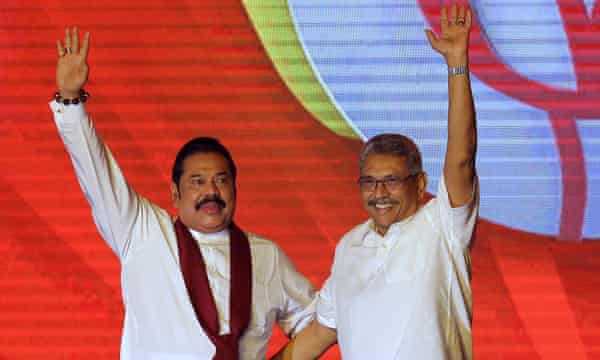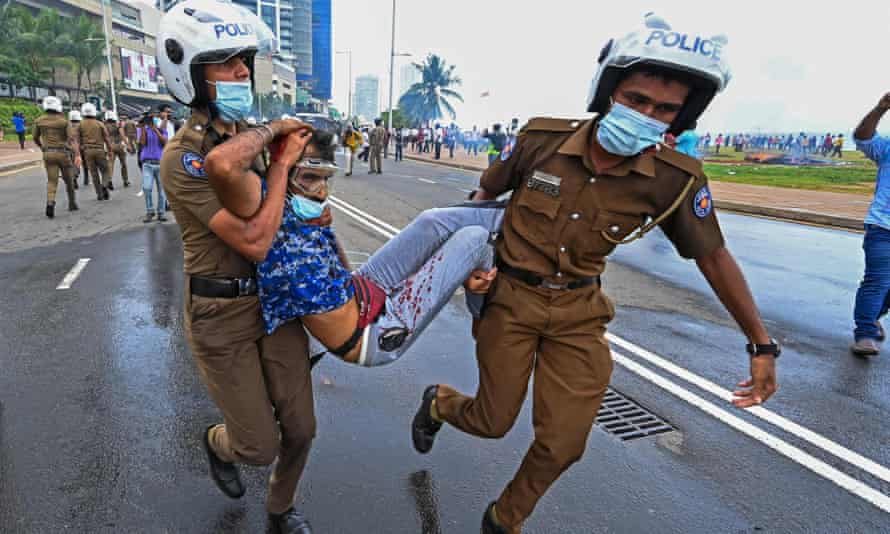Police are imposing nationwide curfew following violence at protest site in Colombo

Sri Lanka’s prime minister, Mahinda Rajapaksa, has resigned after months of protests over the country’s deepening economic crisis, as once-peaceful protests turned violent and at least five people were killed in clashes.
Turmoil began to engulf the country on Monday following violence at a major protest site in Colombo, where pro-government supporters attacked demonstrators and police responded with teargas and water cannon.
Anti-government protestors, who had been largely peaceful, began retaliating across the country. Houses and vehicles of several pro-Rajapaksa politicians and the residence of Mahinda Rajapaksa were set on fire. A nationwide curfew was imposed but five were killed and almost 200 injured.
In one incident just outside of Colombo, a politician from the ruling party opened fire on anti-government protesters blocking his car, killing a 27-year-old, and then later took his own life. According to police, another ruling party politician opened fire on protesters in the southern town of Weeraketiya, killing two and wounding five.
Mahinda Rajapaksa had been asked to resign by his brother, the president, Gotabaya Rajapaksa, at a special meeting on Friday, in an attempt to appease demonstrators who have been taking to the streets in their thousands since March.
Protesters have been calling for both members of Sri Lanka’s powerful Rajapaksa political dynasty to be removed from office for mishandling the economy and plunging the country into the worst financial crisis since independence.
Mahinda Rajapaksa, who was president for a decade between 2005 and 2015, had reportedly been resistant to stepping down, but on Monday submitted his letter of resignation to the president.
“Multiple stakeholders have indicated the best solution to the present crisis is the formation of an interim all-party government. Therefore, I have tendered my resignation so the next steps can be taken in accordance with the Constitution,” he wrote.

The resignation is the latest concession made by the Rajapaksas in the face of protracted anger and protests. The president recently agreed to repeal an amendment to the constitution which had concentrated power in his hands and hand power back to the parliament. Other members of the Rajapaksa family who had previously held seats in the cabinet have also stepped down, with the president the only remaining member of the political family still in power.
Gotabaya Rajapaksa, known widely as Gota, has repeatedly said he will not resign as president, despite the clarion call of the protests being “Gota go home”.
The resignation of Mahinda Rajapaksa means the government will be dissolved. Gotabaya Rajapaksa, who remains as the executive, is expected to invite members of all political parties to form a cross-party cabinet, described as a “unity government”, in an effort to implement some political stability amid the widespread anti-government unrest.
The Rajapaksas have largely controlled Sri Lankan politics for two decades, but the economic crisis has rattled their grip on power in the face of mass unrest from those who had previously been supporters of their brand of chauvinist nationalist politics, which pandered to the country’s Sinhalese Buddhist majority.
Sri Lanka’s foreign reserves have dropped so low that the country cannot afford to import basic essentials, leading to shortages of fuel, food and medicines. People have been forced to endure daily power cuts of up to 10 hours, fuelling mass protests across the country since March.

Over the weekend, the president declared a state of emergency in the country, the second in recent weeks, in a bid to regain control over the streets.
However, Monday marked a violent shift in the demonstrations when hundreds of pro-government supporters gathered outside the prime minister’s residence in Colombo and urged Mahinda Rajapaksa not to resign. The group, some armed with sticks and wooden bars, then launched an attack on an anti-government protest camp nearby, with police reportedly looking on as the clashes began.
Police deployed teargas and water cannon, and around 180 were taken to hospital with injuries. Army and paramilitary troops were deployed to the site and a curfew was declared in the area.
The incident was a catalyst for violence which spread first through the city and then across the country, as the homes and cars of several lawmakers, including Mahinda Rajapaksa’s residence in the city of Kurunegala were set on fire.
Gotabaya Rajapaksa tweeted: “Strongly condemn the violent acts taking place by those inciting & participating, irrespective of political allegiances. Violence won’t solve the current problems.” However, many were quick to point out that the attacks had been prompted by Rajapaksa supporters.
The US ambassador to Sri Lanka condemned “the violence against peaceful protesters today, and [called] on the government to conduct a full investigation, including the arrest and prosecution of anyone who incited violence”.
The economic situation in Sri Lanka remains dire, with the country virtually bankrupt. It has already defaulted on its billions in foreign loans and is in discussions with the International Monetary Fund for an emergency loan and financial assistance to get the country back on its feet.
